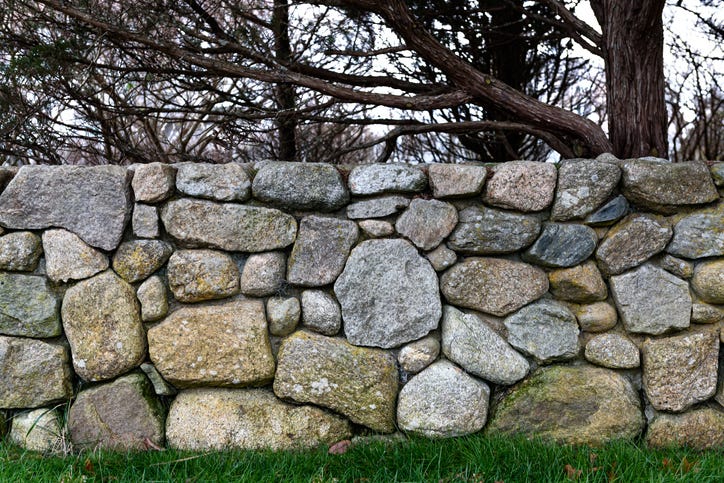Stone Walls, Randomness, and Order
This Spring will have me trying my hand at some stonework. I’ve been reading up, but of course nothing will instill real lessons like giving it a shot.
Last July we had record rainfall and the brook that runs by the house flooded a bit. The running water got itself up and behind an old stone retaining wall, carved out a nice notch, and took out some of the lower stones leading to a leaning and not-so-intact wall. As triage I hauled up a ton (probably more) of stones from the lower brook and filled in behind the wall and in front to serve as riprap on the house-side of the brook, to absorb energy from any future flood. Good enough for now, but not as aesthetically pleasing as what once was. So I will rebuild as best I can, and hopefully it doesn’t come out too ugly.
A stonewall would seem a relatively simple thing, not complex like the stuff of life. Nevertheless building with stone draws out some of the essential relationships between randomness and order that we find ubiquitous in the complex living world.
Randomness and order are often cast as opposite poles on a spectrum: the system can be more ordered or more disordered, but never both at the same time. However in complexity we find complementarity between the two.
When building a stone wall, one of the key pieces of advice is to have a pile of stones much bigger than what you will end up using. The stones are shaped somewhat randomly. Some types of walls are even referred to as “random rubble” walls — a phrase I find quite enjoyable to say.
The wall itself is a bit like a jigsaw puzzle with no right answer but plenty of wrong ones. As one pieces it together, one finds all manner of irregular gaps between laid stones. And this is why you need a big pile: you need to have a rich variety of random stone shapes to find good fits for randomly shaped gaps.1
A stone wall turns out to be an evolutionary process: variety → selection → order. The randomness serves the order. And we need excess variety — the pile of stones bigger than we will use — because we don’t know a priori which random shapes will be needed.2
We also see an interplay of scales in many stonewalls: when irregularities in large stones must be compensated for in detailed ways, small stones are used to fill the irregularly shaped gaps. Having multiscale variety gives us the ability to respond to the large-scale, coarse needs of the growing wall, and the fine-grained detailed needs. Variety not only in shape, but in size.
These ideas are straightforward and in some sense obvious, but typically overlooked in more complex settings where they are essential for achieving order in the midst of uncertainty. Seeing these perennial themes show themselves in the humble stonewall helps to clarify just how foundational they are.
So, that’s the theory. In the next couple of months, as we thaw out from winter, will come the practice. Wish me luck, I’ll report back here.
There are of caveats. Master masons often do a bit of shaping. But the general rule is the less shaping to be done, the better, and having variety will minimize the amount of shaping work needed.
Ashby’s law of requisite variety says we need as much variety in the system as there are varieties in stressors on the system. But we don’t know hw much or which varieties will be needed a priori! Hence, for evolution, we need excess variety.



“You are as special as a stonewall”